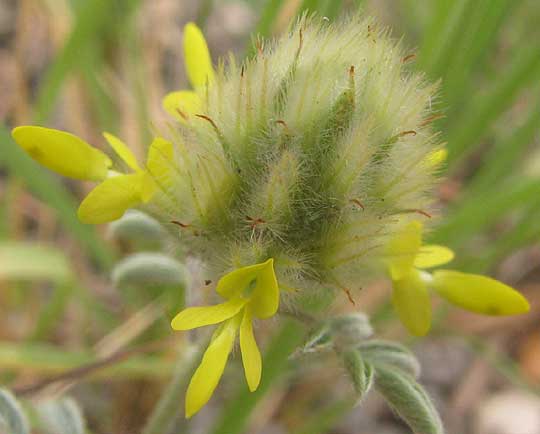Excerpts from Jim Conrad's
Naturalist Newsletter
from the May 18, 2014 Newsletter issued from the Frio Canyon Nature Education Center in the valley of the Dry Frio River in northern Uvalde County, southwestern Texas, on the southern border of the Edwards Plateau; elevation ~1750m (~5750 ft); N29.62°, W99.86°; USA
DWARF PRAIRIE-CLOVER
At the asphalt's very edge a small splash of yellow caught my eye, so I turned the bike back and took a look. It was an especially small wildflower, hardly more than three inches tall (8cm), shown below:
 .
.
Seeing the pinnately compound leaves arising one per stem node, my first impression was that this was member of the big Bean Family, but where those Bean Family flowers? Down on hands and knees, the blossoms looked like they could belong to that family but, if they did, they certainly were unusual with their lower petal so slender and jutting forward so stiffly, and the side petals also jutting out to the sides. A flowering head is seen below:

A closer look at the compound leaves found them heavily mantled with long, slender, straight hairs bending close to the leaflets' surfaces, just like we've seen on several Bean Family species, such as some lupines. A compound leaf with sand splattered on it after a recent shower is shown below:

So, yes, this was a member of the Bean Family, the Fabaceae, and with such distinctive features it didn't take long to figure out that this was some kind of prairie-clover, of the genus Dalea. And Dalea isn't to be confused with "Dahlia," the pretty garden member of the Composite Family.
The Bean Family genus Dalea is a big one, with 100-150 known species. Its species mainly occur in Mexico, and are especially adapted for arid habitats. Therefore, in the US east of the Mississippi river the genus isn't well represented, with only three or four prairie-clover species spottily occurring. However, here we have several, so the challenge was to figure out which Dalea we'd found along the road.
Here are the main field marks of our little prairie-clover:
That last matter of it occurring on limestone is especially important because two very small, yellow-flowered, prairie-clover species occur in our area: Dalea nana and Dalea rubescens. Earlier, and sometimes even now, Dalea rubescens was considered a variety of Dalea nana and both can be called Dwarf Prairie-clover. Billy Turner's 2011 paper "Systematic Study of the Dalea nana Complex" states that Dalea nana inhabits mostly non-calcareous or sandy substrates, while Dalea rubescens lives on calcareous, "non-arenaceous" soils. Limestone is very calcareous; "non-arenaceous" means non-sandy.
Since our plants were on limestone and its flower bracts seem to be of the right shape, our plant appears to be DALEA RUBESCENS, which occurs mostly in arid northeastern Mexico, but extends into the US in Arizona, southern New Mexico, and here in southwestern Texas. In the scrubby southern half of Uvalde County, on the Coastal Plain, I bet they have Dalea nana.